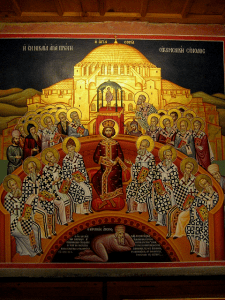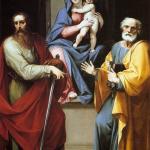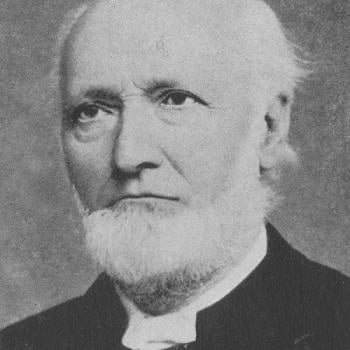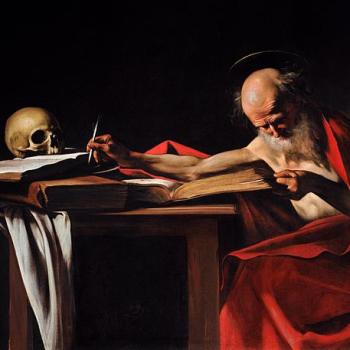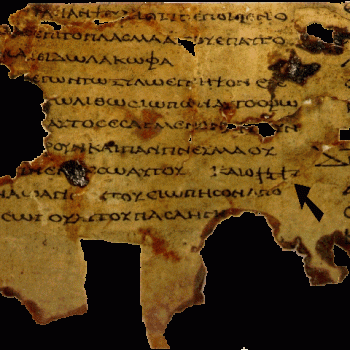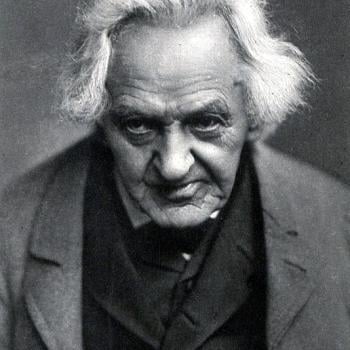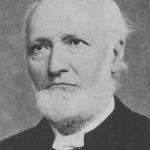Recently I’ve written about St. Jerome’s view on the matter, as well as St. Ignatius of Antioch’s (d. c. 110 or 117). Ignatius is described as the bishop of Antioch by Eusebius (see below). I’ve also written about how St. Clement of Rome (c. 35-99) seems to be acting as a pope in his letter to the Corinthians. He is identified as the bishop of Rome by both St. Irenaeus and Eusebius (see below).
Now I’ll take a look at some other early fathers and the father of Church history, Eusebius, to see what they thought about it.
Hear now with regard to the stones which are in the building. Those square white stones which fitted exactly into each other, are apostles, bishops, teachers, and deacons, who have lived in godly purity, and have acted as bishops and teachers and deacons chastely and reverently to the elect of God. (Shepherd of Hermas, Vision 3, 5)
Visions 1-4 suggest to some scholars a date of 95 to 100 for this document, which was considered to be canonical Scripture by Irenaeus, Clement of Alexandria, Origen, Tertullian, and Athanasius. But the Muratorian Canon [c. 180-200], the oldest list of New Testament writings, stated, “The Pastor, moreover, did Hermas write very recently in our times in the city of Rome, while his brother bishop Pius sat in the chair of the Church of Rome.” Pius reigned as pope and bishop of Rome from c. 140 to c. 154. Thus, some think that the Shepherd of Hermas is a composite document. It’s certainly — as a whole — no later than 175-180, when Irenaeus referred to it.
Polycarp . . . having in our own times been an apostolic and prophetic teacher, and bishop of the Catholic Church which is in Smyrna. (Martyrdom of Polycarp, 16; the date of Polycarp’s death is generally thought to be somewhere between 156 and 167; the letter was written by the church in Smyrna by eyewitnesses of Polycarp’s gruesome martyrdom)
Some have argued that Justin Martyr (d. 165) referred to a monepiscopate in his use of the term “president” (First Apology, 65, 67).
Eusebius, in his Ecclesiastical History, states that Dionysius of Corinth [bishop of Corinth in 171]
mentions Quadratus [d. 129] also, stating that he was appointed their [Athenians’] bishop after the martyrdom of Publius [d. c. 112 or c. 125; St. Luke refers to him as “the chief man of the island” of Malta: Acts 28:7], . . . He records, moreover, that Dionysius the Areopagite [d. bef. 100], who was converted to the faith by the apostle Paul, according to the statement in the Acts of the Apostles [17:34], first obtained the episcopate of the church at Athens. (EH, Bk IV, 23, 3; my own links in the text; Narcissus, mentioned by Paul in Rom 16:11, preceded Publius as Bishop of Athens)
Writing also to the church that is in Gortyna, together with the other parishes in Crete, he commends their bishop Philip [d. 180], because of the many acts of fortitude which are testified to as performed by the church under him, and he warns them to be on their guard against the aberrations of the heretics. (EH, Bk IV, 23, 5; my own link in the text)
Among these is inserted also another epistle addressed to the Cnosians [Knossos in Crete], in which he exhorts Pinytus [d. 180], bishop of the parish, . . . (EH, Bk IV, 23, 7; my own link in the text)
There is extant also another epistle written by Dionysius to the Romans, and addressed to Soter [r. c. 169 – 174], who was bishop at that time. . . . (EH, Bk IV, 23, 9-10; my own link in the text; Bacchylus was bishop of Corinth in 199, according to Eusebius: Bk. V, 22)
St. Irenaeus (130-202) famously wrote, around 175-180 AD:
The blessed apostles, then, having founded and built up the Church, committed into the hands of Linus the office of the episcopate. Of this Linus [start of reign: 64-68], Paul makes mention in the Epistles to Timothy [2 Tim 4:21]. To him succeeded Anacletus [r. c. 79 – c. 92]; and after him, in the third place from the apostles, Clement [r. 88-99] was allotted the bishopric. This man, as he had seen the blessed apostles, and had been conversant with them, might be said to have the preaching of the apostles still echoing [in his ears], and their traditions before his eyes. Nor was he alone [in this], for there were many still remaining who had received instructions from the apostles. In the time of this Clement, no small dissension having occurred among the brethren at Corinth, the Church in Rome dispatched a most powerful letter to the Corinthians, exhorting them to peace, renewing their faith, and declaring the tradition which it had lately received from the apostles, . . . To this Clement there succeeded Evaristus [r. c. 99- c. 107]. Alexander [r. c. 107- c. 115] followed Evaristus; then, sixth from the apostles, Sixtus [r. c. 115- c. 124] was appointed; after him, Telephorus [or, Telesphorus; c. 126- c. 137], who was gloriously martyred; then Hyginus [r. c. 136- c. 142]; after him, Pius [r. c. 140- c. 154]; then after him, Anicetus [r. c. 157- c. 168]. Soter having succeeded Anicetus, Eleutherius [r. c. 174-189] does now, in the twelfth place from the apostles, hold the inheritance of the episcopate. In this order, and by this succession, the ecclesiastical tradition from the apostles, and the preaching of the truth, have come down to us. And this is most abundant proof that there is one and the same vivifying faith, which has been preserved in the Church from the apostles until now, and handed down in truth. (Against Heresies, Bk III, 3, 3; my own links in the text; cited in Eusebius, EH, Bk V, 6, 1-5)
Irenaeus writes in several places about apostolic succession: that is, the notion that bishops are the appointed successors of the apostles:
It is within the power of all, therefore, in every Church, who may wish to see the truth, to contemplate clearly the tradition of the apostles manifested throughout the whole world; and we are in a position to reckon up those who were by the apostles instituted bishops in the Churches, and [to demonstrate] the succession of these men to our own times; those who neither taught nor knew of anything like what these [heretics] rave about. For if the apostles had known hidden mysteries, which they were in the habit of imparting to
the perfectapart and privily from the rest, they would have delivered them especially to those to whom they were also committing the Churches themselves. For they were desirous that these men should be very perfect and blameless in all things, whom also they were leaving behind as their successors, delivering up their own place of government to these men; which men, . . . (Against Heresies, Bk III, 3, 3, 1)But Polycarp also was not only instructed by apostles, and conversed with many who had seen Christ, but was also, by apostles in Asia, appointed bishop of the Church in Smyrna, whom I also saw in my early youth, for he tarried [on earth] a very long time, and, when a very old man, gloriously and most nobly suffering martyrdom, departed this life, having always taught the things which he had learned from the apostles, and which the Church has handed down, and which alone are true. To these things all the Asiatic Churches testify, as do also those men who have succeeded Polycarp down to the present time . . . He it was who, coming to Rome in the time of Anicetus caused many to turn away from the aforesaid heretics to the Church of God, proclaiming that he had received this one and sole truth from the apostles — that, namely, which is handed down by the Church. (Against Heresies, Bk III, 3, 3, 4)
Wherefore it is incumbent to obey the presbyters who are in the Church — those who, as I have shown, possess the succession from the apostles; those who, together with the succession of the episcopate, have received the certain gift of truth, according to the good pleasure of the Father. But [it is also incumbent] to hold in suspicion others who depart from the primitive succession, and assemble themselves together in any place whatsoever, [looking upon them] either as heretics of perverse minds, or as schismatics puffed up and self-pleasing, or again as hypocrites, acting thus for the sake of lucre and vainglory. For all these have fallen from the truth. (Against Heresies, Bk IV, 26, 2)
True knowledge is [that which consists in] the doctrine of the apostles, and the ancient constitution of the Church throughout all the world, and the distinctive manifestation of the body of Christ according to the successions of the bishops, by which they have handed down that Church which exists in every place, . . . (Against Heresies, Bk IV, 33, 8)
Now all these [heretics] are of much later date than the bishops to whom the apostles committed the Churches; which fact I have in the third book taken all pains to demonstrate. (Against Heresies, Bk V, 20, 1)
Likewise, Hegesippus [fl. c. 180] bore witness to apostolic succession and monepiscopacy:
Hegesippus in the five books of Memoirs which have come down to us has left a most complete record of his own views. In them he states that on a journey to Rome he met a great many bishops, and that he received the same doctrine from all. It is fitting to hear what he says after making some remarks about the epistle of Clement to the Corinthians. His words are as follows: “And the church of Corinth continued in the true faith until Primus was bishop in Corinth. I conversed with them on my way to Rome, and abode with the Corinthians many days, during which we were mutually refreshed in the true doctrine. And when I had come to Rome I remained there until Anicetus, whose deacon was Eleutherus. And Anicetus was succeeded by Soter, and he by Eleutherus. In every succession, and in every city that is held which is preached by the law and the prophets and the Lord.” The same author also describes the beginnings of the heresies which arose in his time, in the following words: “And after James the Just had suffered martyrdom, as the Lord had also on the same account, Symeon, the son of the Lord’s uncle, Clopas, was appointed the next bishop. All proposed him as second bishop because he was a cousin of the Lord. (EH, IV, 22, 1-4)
Tertullian strongly taught apostolic succession in c. 200 AD:
But if there be any (heresies) which are bold enough to plant themselves in the midst of the apostolic age, that they may thereby seem to have been handed down by the apostles, because they existed in the time of the apostles, we can say: Let them produce the original records of their churches; let them unfold the roll of their bishops, running down in due succession from the beginning in such a manner that [that first bishop of theirs ] bishop shall be able to show for his ordainer and predecessor some one of the apostles or of apostolic men, — a man, moreover, who continued steadfast with the apostles. For this is the manner in which the apostolic churches transmit their registers: as the church of Smyrna, which records that Polycarp was placed therein by John; as also the church of Rome, which makes Clement to have been ordained in like manner by Peter. In exactly the same way the other churches likewise exhibit (their several worthies), whom, as having been appointed to their episcopal places by apostles, they regard as transmitters of the apostolic seed. Let the heretics contrive something of the same kind. (Prescription against Heretics, 32)
And again between 207 and 212:
We have also St. John’s foster churches. For although Marcion rejects his Apocalypse, the order of the bishops (thereof), when traced up to their origin, will yet rest on John as their author. In the same manner is recognised the excellent source of the other churches. (Against Marcion, Bk IV, 5)
St. Clement of Alexandria (c. 150- c. 215) wrote between 190 and 210:
[L]isten to a tale, which is not a tale but a narrative, handed down and committed to the custody of memory, about the Apostle John. For when, on the tyrant’s death [Emperor Domitian in 96], he returned to Ephesus from the isle of Patmos, he went away, being invited, to the contiguous territories of the nations, here to appoint bishops, there to set in order whole Churches, there to ordain such as were marked out by the Spirit. (Who is the Rich Man That Shall Be Saved?, 42; cited in Eusebius, EH, Bk III, 23, 5-6)
And in another writing, between 202 and 216:
Since, according to my opinion, the grades here in the Church, of bishops, presbyters, deacons, are imitations of the angelic glory, and of that economy which, the Scriptures say, awaits those who, following the footsteps of the apostles, have lived in perfection of righteousness according to the Gospel. (Stromata, Book VI, 13)
Likewise, St. Cyprian (210-258):
Whence you ought to know that the bishop is in the Church, and the Church in the bishop; and if any one be not with the bishop, that he is not in the Church, . . . (Ep. 68, 8)
Therefore the power of remitting sins was given to the apostles, and to the churches which they, sent by Christ, established, and to the bishops who succeeded to them by vicarious ordination. But the enemies of the one Catholic Church in which we are, and the adversaries of us who have succeeded the apostles, asserting for themselves, in opposition to us, unlawful priesthoods, . . . (Ep. 74, 16)
Firmilian of Caesarea wrote to St. Cyprian in 255 or 256:
[T]he power of forgiving sins was given to the Apostles and to the Churches which these men, sent by Christ, established; and to the bishops who succeeded them by being ordained in their place. (Letter 75, 16, 5; from William A. Jurgens, The Faith of the Early Fathers, Vol. 1 [Collegeville, Minnesota: The Liturgical Press, 1970], p. 245)
The well-known Protestant Church historian Philip Schaff, editor of the 38-volume set of the Church fathers, wrote about early ecclesiology:
Besides appealing to the Scriptures, the fathers, particularly Irenaeus and Tertullian [c. 160- c. 225], refer with equal confidence to the “rule of faith;” that is, the common faith of the church, as orally handed down in the unbroken succession of bishops from Christ and his apostles to their day, and above all as still living in the original apostolic churches, like those of Jerusalem, Antioch, Ephesus, and Rome. Tradition is thus intimately connected with the primitive episcopate. The latter was the vehicle of the former, and both were looked upon as bulwarks against heresy.
Irenaeus confronts the secret tradition of the Gnostics with the open and unadulterated tradition of the catholic church, and points to all churches, but particularly to Rome, as the visible centre of the unity of doctrine. All who would know the truth, says he, can see in the whole church the tradition of the apostles; and we can count the bishops ordained by the apostles, and their successors down to our time, who neither taught nor knew any such heresies. Then, by way of example, he cites the first twelve bishops of the Roman church from Linus to Eleutherus, as witnesses of the pure apostolic doctrine. He might conceive of a Christianity without scripture, but he could not imagine a Christianity without living tradition; and for this opinion he refers to barbarian tribes, who have the gospel, “sine charta et atramento,” written in their hearts.
Tertullian finds a universal antidote for all heresy in his celebrated prescription argument, which cuts off heretics, at the outset, from every right of appeal to the holy scriptures, on the ground, that the holy scriptures arose in the church of Christ, were given to her, and only in her and by her can be rightly understood. He calls attention also here to the tangible succession, which distinguishes the catholic church from the arbitrary and ever-changing sects of heretics, and which in all the principal congregations, especially in the original sects of the apostles, reaches back without a break from bishop to bishop, to the apostles themselves, from the apostles to Christ, and from Christ to God. “Come, now,” says he, in his tract on Prescription, “if you would practise inquiry to more advantage in the matter of your salvation, go through the apostolic churches, in which the very chairs of the apostles still preside, in which their own authentic letters are publicly read, uttering the voice and representing the face of every one. If Achaia is nearest, you have Corinth. If you are not far from Macedonia, you have Philippi, you have Thessalonica. If you can go to Asia, you have Ephesus. But if you live near Italy, you have Rome, whence also we [of the African church] derive our origin. How happy is the church, to which the apostles poured out their whole doctrine with their blood,” etc.
To estimate the weight of this argument, we must remember that these fathers still stood comparatively very near the apostolic age, and that the succession of bishops in the oldest churches could be demonstrated by the living memory of two or three generations. Irenaeus in fact, had been acquainted in his youth with Polycarp, a disciple of St. John. (History of the Christian Church, Vol. 2, Chapter XII, section 139, “Catholic Tradition,” pp. 525 ff.)
The Ecclesiastical History, by Eusebius (c. 260/265-339) was the first and by far most important comprehensive history of the Church, and was completed in its first edition before 300 AD. It has a wealth of information about monarchical bishops from very early on in Church history:
Then James, whom the ancients surnamed the Just on account of the excellence of his virtue, is recorded to have been the first to be made bishop of the church of Jerusalem. . . . Clement in the sixth book of his Hypotyposes writes thus: “For they say that Peter and James and John after the ascension of our Saviour, as if also preferred by our Lord, strove not after honor, but chose James the Just bishop of Jerusalem.” (EH, Bk II, 1, 2-3)
When Nero was in the eighth year of his reign [62 AD], Annianus succeeded Mark the evangelist in the administration of the parish of Alexandria. (Bk II, 24, 1; according to Bk III, ch. 14, he held his office for twenty-two years [84])
. . . Zephyrinus [r. 199-217], bishop of Rome. (EH, Bk II, 25, 6)
After the martyrdom of Paul and of Peter, Linus [start of reign between 64-68] was the first to obtain the episcopate of the church at Rome. Paul mentions him, when writing to Timothy from Rome, in the salutation at the end of the epistle. [2 Tim 4:21] (EH, Bk III, 2, 1; cf. III, 4, 9. In Bk III, ch. 13, Eusebius says that Linus was bishop for twelve years)
Timothy [d. c. 97], so it is recorded, was the first to receive the episcopate of the parish in Ephesus, Titus [d. 96 or 107] of the churches in Crete. (EH, Bk III, 4, 6)
Clement also, who was appointed third bishop of the church at Rome, was, as Paul testifies, his co-laborer [Phil 4:3] . . . (EH, Bk III, 4, 10)
Besides these, that Areopagite, named Dionysius [d. bef. 100], who was the first to believe after Paul’s address to the Athenians in the Areopagus (as recorded by Luke in the Acts [17:34]) is mentioned by another Dionysius, an ancient writer and pastor of the parish in Corinth, as the first bishop of the church at Athens. (EH, Bk III, 4, 11)
After the martyrdom of James [c. 69] and the conquest of Jerusalem which immediately followed, it is said that those of the apostles and disciples of the Lord that were still living came together from all directions with those that were related to the Lord according to the flesh (for the majority of them also were still alive) to take counsel as to who was worthy to succeed James. They all with one consent pronounced Symeon, the son of Clopas [d. c. 107 or 117], of whom the Gospel also makes mention [Jn 19:25]; to be worthy of the episcopal throne of that parish. He was a cousin, as they say, of the Saviour. For Hegesippus records that Clopas was a brother of Joseph. (EH, Bk III, 11, 1-2; cf. III, 32, 1 and Hegesippus’ account in IV, 22, 4)
After Vespasian had reigned ten years Titus [r. 79-81], his son, succeeded him. In the second year of his reign, Linus, who had been bishop of the church of Rome for twelve years, delivered his office to Anencletus. (EH, Bk III, 13, 1)
In the fourth year of Domitian [85], Annianus, the first bishop of the parish of Alexandria, died after holding office twenty-two years, and was succeeded by Abilius [d. 98], the second bishop. (EH, Bk III, 14, 1)
In the twelfth year of the same reign [92/93] Clement succeeded Anencletus after the latter had been bishop of the church of Rome for twelve years. (EH, Bk III, 15, 1)
After Nerva had reigned a little more than a year he was succeeded by Trajan. It was during the first year of his reign [98] that Abilius, who had ruled the church of Alexandria for thirteen years, was succeeded by Cerdon [d. c. 106-109; cf. IV, ch. 1]. He was the third that presided over that church after Annianus, who was the first. At that time Clement still ruled the church of Rome, being also the third that held the episcopate there after Paul and Peter. Linus was the first, and after him came Anencletus. (EH, Bk III, 21, 1-3)
At this time Ignatius was known as the second bishop of Antioch, Evodius [r. c. 53-66] having been the first. Symeon likewise was at that time the second ruler of the church of Jerusalem, the brother of our Saviour having been the first. (EH, Bk III, 22, 1)
In the third year of the reign of the emperor mentioned above [Trajan: 101], Clement committed the episcopal government of the church of Rome to Evarestus, and departed this life after he had superintended the teaching of the divine word nine years in all. (EH, Bk III, 34, 1)
But when Symeon also had died [during Trajan’s reign: 98-117] in the manner described, a certain Jew by the name of Justus succeeded to the episcopal throne in Jerusalem. (EH, Bk III, 35, 1)
About the twelfth year of the reign of Trajan [110] the above-mentioned bishop of the parish of Alexandria [Cedron] died, and Primus, the fourth in succession from the apostles, was chosen to the office. At that time also Alexander [r. c. 107-109 – c. 115-119], the fifth in the line of succession from Peter and Paul, received the episcopate at Rome, after Evarestus had held the office eight years. (EH, Bk IV, 1, 1-2)
In the third year of the same reign [Hadrian: 119-120], Alexander, bishop of Rome, died after holding office ten years. His successor was Xystus [r. c. 119-c. 129]. About the same time Primus, bishop of Alexandria, died in the twelfth year of his episcopate, and was succeeded by Justus. (EH, Bk IV, 4, 1)
[U]ntil the siege of the Jews, which took place under Adrian [132-135], there were fifteen bishops in succession there [Jerusalem], . . . it is proper to give here a list of their names from the beginning. The first, then, was James [d. 62], the so-called brother of the Lord; the second, Symeon [r. 62-107]; the third, Justus [r. 107-113]; the fourth, Zacchæus [r. 113 – ?]; the fifth, Tobias; the sixth, Benjamin [r. ? – 117]; the seventh, John [r. 117 – ?]; the eighth, Matthias [r. ? – 120] the ninth, Philip [r. 120 – ?]; the tenth, Seneca; the eleventh, Justus; the twelfth, Levi; the thirteenth, Ephres; the fourteenth, Joseph; and finally, the fifteenth, Judas [r. ? – 135]. (EH, Bk IV, 5, 2-3)
In the twelfth year of the reign of Adrian [128-129], Xystus [Sixtus], having completed the tenth year of his episcopate [in Rome], was succeeded by Telesphorus [c. 128 – c. 139], the seventh in succession from the apostles. In the meantime, after the lapse of a year and some months, Eumenes, the sixth in order, succeeded to the leadership of the Alexandrian church, his predecessor [Justus, r. c. 120 – c. 131] having held office eleven years. (EH, Bk IV, 5, 5)
Adrian [Hadrian] having died after a reign of twenty-one years [138], was succeeded in the government of the Romans by Antoninus, called the Pious [r. 138-161]. In the first year of his reign [138-139] Telesphorus died in the eleventh year of his episcopate, and Hyginus [r. c. 138 – c. 142] became bishop of Rome. (EH, Bk IV, 10, 1)
In the eighth year of the above-mentioned reign [169] Soter [r. c. 169 – 174] succeeded Anicetus [r. c. 158 – c. 169] as bishop of the church of Rome, after the latter had held office eleven years in all. But when Celadion [r. 152-166] had presided over the church of Alexandria for fourteen years he was succeeded by Agrippinus [r. 167-178]. (EH, Bk IV, 19, 1)
At that time also in the church of Antioch, Theophilus [169-182] was well known as the sixth from the apostles. For Cornelius [r. 127 – 154], who succeeded Hero [c. 116-136], was the fourth, and after him Eros [r. 154 – c. 169] the fifth in order, had held the office of bishop. (EH, Bk IV, 20, 1)
Maximinus [182-191], the seventh from the apostles, succeeded him [Theophilus] as bishop of the church of Antioch. (EH, Bk IV, 24, 3)
After Antoninus had been emperor for nineteen years, Commodus received the government. In his first year [180] Julian [r. 180 – c. 190] became bishop of the Alexandrian churches, after Agrippinus [r. 168-180] had held the office for twelve years. (EH, Bk V, 9, 1)
In the tenth year of the reign of Commodus [187], Victor [r. 187-199] succeeded Eleutherus [r. 174-187], the latter having held the episcopate [in Rome] for thirteen years. In the same year, after Julian had completed his tenth year, Demetrius [r. 190 – c. 224 to 232] received the charge of the parishes at Alexandria. At this time the above-mentioned Serapion [191-211], the eighth from the apostles, was still well known as bishop of the church at Antioch. Theophilus presided at Cæsarea in Palestine [r. c. 189-195]; and Narcissus, whom we have mentioned before, still had charge of the church at Jerusalem. Bacchylus at the same time [199] was bishop of Corinth in Greece, and Polycrates [d. 196?] of the parish of Ephesus. (EH, Bk V, 22, 1)
Regarding the confusion or mixed reports about the chronology of the earliest popes, see, “Pope St. Clement I” (Catholic Encyclopedia, John Chapman, 1908). He states, for example: “At the present time no critic doubts that Cletus, Anacletus, Anencletus, are the same person. Anacletus is a Latin error; Cletus is a shortened (and more Christian) form of Anencletus.”
Further Reading
Were Early Churches Governed by Individual Bishops, or Groups of Elders? (Joe Heschmeyer, Shameless Popery, 9-1-19)
The Bishops of History and the Catholic Faith: A Reply To Brandon Addison (Bryan Cross, Called to Communion, 6-8-14; very long and marvelously detailed)
Was the ‘one bishop per city’ model of church leadership an unbiblical corruption by Catholicism? (A brief look at the monespiscopate) (Nick’s Catholic Blog, 10-25-16)
“Apostolic Succession” section on my Church web page.
50 New Testament Proofs for Petrine Primacy & the Papacy [1994]
Pope St. Clement of Rome & Papal Authority [7-28-21]
Is First Clement Non-Papal? (vs. Jason Engwer) [4-19-22]
St. Jerome, Papacy, & Succession (Vs. Gavin Ortlund) [1-20-24]
Ignatius Of Antioch On Monarchical Bishops [1-25-24]
*
***
*
Practical Matters: Perhaps some of my 4,500+ free online articles (the most comprehensive “one-stop” Catholic apologetics site) or fifty-five books have helped you (by God’s grace) to decide to become Catholic or to return to the Church, or better understand some doctrines and why we believe them.
Or you may believe my work is worthy to support for the purpose of apologetics and evangelism in general. If so, please seriously consider a much-needed financial contribution. I’m always in need of more funds: especially monthly support. “The laborer is worthy of his wages” (1 Tim 5:18, NKJV). 1 December 2021 was my 20th anniversary as a full-time Catholic apologist, and February 2022 marked the 25th anniversary of my blog.
PayPal donations are the easiest: just send to my email address: [email protected]. Here’s also a second page to get to PayPal. You’ll see the term “Catholic Used Book Service”, which is my old side-business. To learn about the different methods of contributing (including Zelle), see my page: About Catholic Apologist Dave Armstrong / Donation Information. Thanks a million from the bottom of my heart!
*
***
Photo credit: Jjensen (8-23-08). Icon from the Mégalo Metéoron Monastery in Greece, representing the First Ecumenical Council of Nicaea in 325 A.D., with the condemned Arius in the bottom of the icon. [Wikimedia Commons / Creative Commons Attribution-Share Alike 3.0 Unported license]
Summary: I detail the evidence from early Fathers and Eusebius for monarchical (single) bishops being in place in cities and areas in the first and second centuries.


